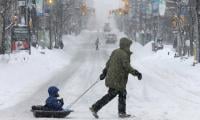GLOF, vulnerabilities and local action
In my previous article, ‘Integrating GLOF into policy’ (January 4), I argued that increased frequency of Glacial Lake Outburst Flood (GLOF) makes it necessary for Pakistan to establish locally workable mechanisms to enhance the resilience of vulnerable communities.
This means that these local institutions have the capacity to identify and manage GLOF-induced risks, and they have resources to implement mitigation and adaptation action plans.
The most urgent action to address the potential destruction of GLOFs is to enhance the technical and technological capacity to undertake timely risk assessment of glacier melt through hydrological monitoring and forecasting. The existing technology of early warning systems lacks the capacity of risk management and timely dissemination of risks to downstream communities. Also, the existing disaster management policies and risk reduction and preparedness plans do not incorporate the GLOF-specific behavioral, institutional and functional peculiarities of disasters.
Contrary to our wishes, Pakistan presents rather a dismal picture in its performance of climate change risk reduction and GLOF does not even make a recognizable mention as a serious threat. The Global Climate Risk Index 2020 ranks Pakistan on the fifth place in the world in terms of its vulnerability to climate change effects. According to the report, Pakistan lost 9,989 lives and its economy suffered from $3.8 billion losses from 1999 to 2018.
GLOF events have a significant part in these national losses, and need to be fully reflected in the policy discourse on climate change. In Chitral alone, the cost of rehabilitation, reconstruction and economic rival in the aftermath of GLOF events of 2015 was estimated at $100 million. You can imagine why Chitral continues to present a picture of lasting misery even after more than five years of disaster.
Climate change has become a provincial subject after the 18th Amendment to the constitution of Pakistan. This means that, in addition to the devolution of the power of legislation to the province, it has led to fiscal federalism too. While other provinces of Pakistan have their own revenues to invest in climate change adaptation and mitigation, Gilgit-Baltistan being the most affected region by climate change is dependent on annual grants from the federal government.
One may argue that since the 18th Amendment has not been extended to GB, therefore all federal laws and policies are still valid as governing framework in GB. In practice, however, this is much complicated given the lack of local institutional capacity, lack of financial resources at the disposal of the federal government and the political disenfranchisement of the people of GB. Can we not do anything then? Well, we can at least come up with an elaborate mitigation and adaptation action plan for GB.
There are three key dimensions which must be considered as central to mitigation and adaptation action plans to minimize the adverse impacts of GLOF. First dimension is about mitigation through long term planning for controlling deforestation, minimizing carbon emissions and other locally viable measures to minimize GLOF events. This calls for some trans-boundary arrangements between neighboring countries which share the cryosphere and whose collective action can help reduce the melting pace of frozen water.
The second dimension is about formulation of well-defined national and sub-national adaptation action plans to reduce the adverse impacts of GLOF on the lives, livelihoods, physical infrastructure, natural resources and social resources of downstream mountain communities. This involves deploying efficient early warning systems, rapid institutional response and community awareness raising campaigns about timely evacuation. The mitigation plan must also entail measures to construct GLOF-compatible physical infrastructure, undertake slope stabilization measures and downstream plantation to reduce erosion and land-sliding in the event of GLOF.
The third dimension is about local risk assessment, hazard mapping, and collection of historical data on flood frequency and mapping of key stakeholders of institutional response.
It is important to note that both mitigation and adaptation are important parts of the GLOF risk reduction strategy, though they are not mutually exclusive. Mitigation measures are devised to address the root cause of the GLOF phenomenon – actions to reduce the pace of melting of glaciers in the long run. It requires regional and international commitments to reduce carbon emissions and long-term national planning to overcome deforestation and desertification. Adaptation is about reducing the adverse impact of GLOF at the local level, which calls for local action to minimize the vulnerabilities of downstream mountain communities
As part of GLOF risk reduction, it is important to install efficient early warning systems, flood discharge sensors, and construct small-scale protective infrastructure. People must also be provided with alternate and climate-resilient livelihood options to help reduce the economic burden of disaster.
A GLOF risk reduction strategy must be substantiated by an analysis of historical data, trends and frequency of disasters and the forecasts. This will help identify the nature and degree of vulnerability or risk, as well as the identification of vulnerable groups. Once identification of vulnerabilities and assessment of risk is carried out, the prioritization of geographical areas for appropriate mitigation and adaptation measures becomes an easy task. The process of hazard mapping and vulnerability/risk assessments helps not only in identifying, diagnosing and prioritizing risks but also creates awareness and knowledge of addressing the risks.
The effective and durable way to address the risks of GLOF is to strengthen the capacities of the most vulnerable segments of society who must have adequate information and skills to reduce the impact of hazards on their lives and livelihoods. GLOF risk reduction must be built upon the existing local institutions of the downstream mountainous communities who must be trained to have appropriate skills to make use of coping mechanisms. Engaging communities even in vulnerability and risk assessments help build awareness, commitment and resilience against GLOFs.
Women, children, people with special needs and the poor are the most vulnerable groups who generally bear the brunt of miseries inflicted upon communities in a GLOF-induced disaster. Ranging from a patriarchal mindset, to political exclusion, to economic marginalization, these vulnerable groups may not get the opportunity to benefit from awareness programs about GLOF-coping mechanisms. It is, therefore, of utmost importance to engage women, people with special needs and the poor as stakeholders in the process of building resilience against GLOF.
GLOF risk reduction mechanisms must be contextual, local and must be organically linked with grassroots institutions of the people. GLOF mitigation and adaptation action plans can be effective at the district and UC levels, because of the historical knowledge and varying nature and degree of vulnerabilities associated with particular geographical settings and customs.
National and provincial policies can only provide an overarching framework for GLOF risk reduction but it is for the district and municipal governments, together with local civil society groups, to act in unison to promote risk-reduction behavior among vulnerable communities.
The writer is a social development and policy adviser, and a freelance columnist based in Islamabad.
Email: ahnihal@yahoo.com
Twitter: @AmirHussain76
-
 Canada Snowbirds Rethink Travel To US As New Rules Cause Concern
Canada Snowbirds Rethink Travel To US As New Rules Cause Concern -
 Google Introduces Willow, One Of World’s Most Powerful Quantum Computers
Google Introduces Willow, One Of World’s Most Powerful Quantum Computers -
 South Korea: President Lee To Visit Japan For Summit With PM Takaichi
South Korea: President Lee To Visit Japan For Summit With PM Takaichi -
 Bruno Mars Drops First Single From 'The Romantic'
Bruno Mars Drops First Single From 'The Romantic' -
 Disney+ Introduces TikTok-style Short-form Vertical Videos
Disney+ Introduces TikTok-style Short-form Vertical Videos -
 How Gene Therapy Could Change The Future Of Chronic Pain Treatment
How Gene Therapy Could Change The Future Of Chronic Pain Treatment -
 China’s Second ‘AI Tiger’ MiniMax, Soars In Record-breaking Hong Kong Market Debut
China’s Second ‘AI Tiger’ MiniMax, Soars In Record-breaking Hong Kong Market Debut -
 Trump Administration Establishes New Anti-fraud Division Under DOJ
Trump Administration Establishes New Anti-fraud Division Under DOJ -
 Andrew Windsor, Sarah Ferguson Fear Charges, Exile And Total Ruin
Andrew Windsor, Sarah Ferguson Fear Charges, Exile And Total Ruin -
 Andrew Raw Emotions Exposed Over His Daughters’ Choice: ‘Live And Die By This’
Andrew Raw Emotions Exposed Over His Daughters’ Choice: ‘Live And Die By This’ -
 Experts Weigh In On Why Nick Reiner's Lawyer Stepped Down From Murder Trial
Experts Weigh In On Why Nick Reiner's Lawyer Stepped Down From Murder Trial -
 Fetty Wap Granted Early Release From Prison In Drug Trafficking Case
Fetty Wap Granted Early Release From Prison In Drug Trafficking Case -
 Trump To Host Nobel Laureate Machado In Washington Next Week
Trump To Host Nobel Laureate Machado In Washington Next Week -
 Reason Behind Kate Middleton’s Missing Engagement Ring From First Appearance Of 2026 Explained
Reason Behind Kate Middleton’s Missing Engagement Ring From First Appearance Of 2026 Explained -
 Kelsea Ballerini Bids Emotional Farewell To Deceased Pet
Kelsea Ballerini Bids Emotional Farewell To Deceased Pet -
 Meghan Markle's Recent Comment On Mom Doria Raises Eyebrows: Source
Meghan Markle's Recent Comment On Mom Doria Raises Eyebrows: Source



